Module 5 Unit2 It describes the changes in Chinese society. 课件 +嵌入视频(共24张PPT)
文档属性
| 名称 | Module 5 Unit2 It describes the changes in Chinese society. 课件 +嵌入视频(共24张PPT) |

|
|
| 格式 | pptx | ||
| 文件大小 | 118.4MB | ||
| 资源类型 | 教案 | ||
| 版本资源 | 外研版 | ||
| 科目 | 英语 | ||
| 更新时间 | 2022-11-25 20:16:32 | ||
图片预览

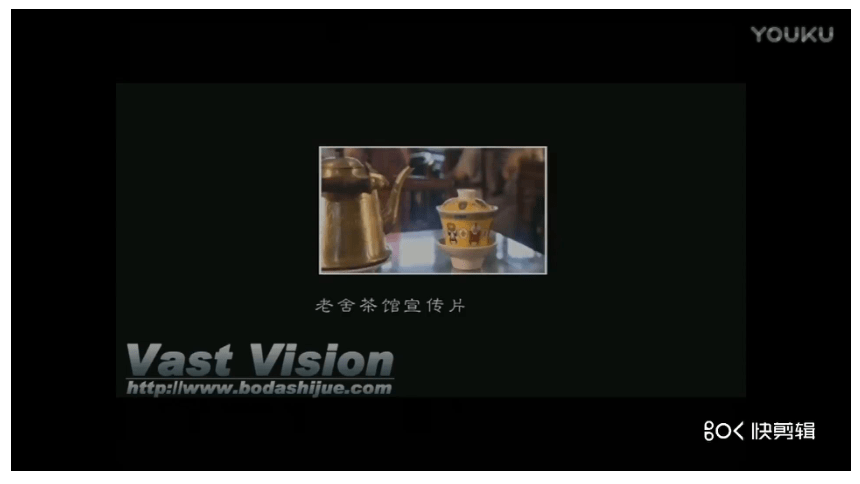
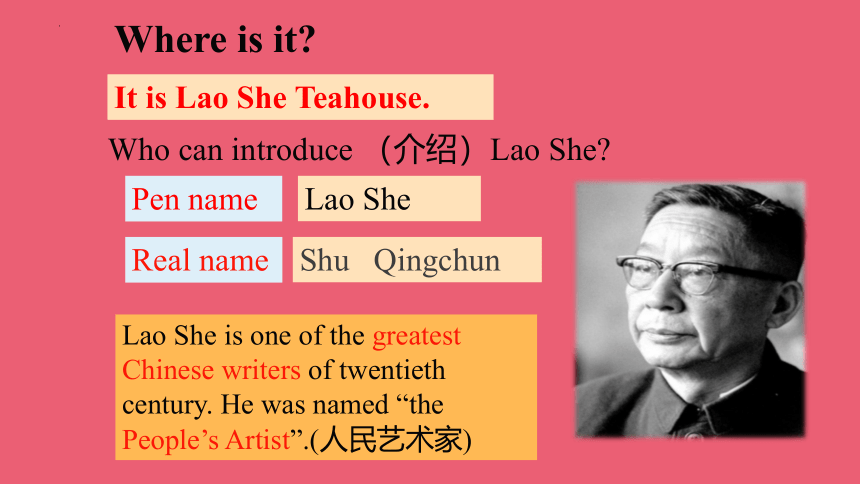

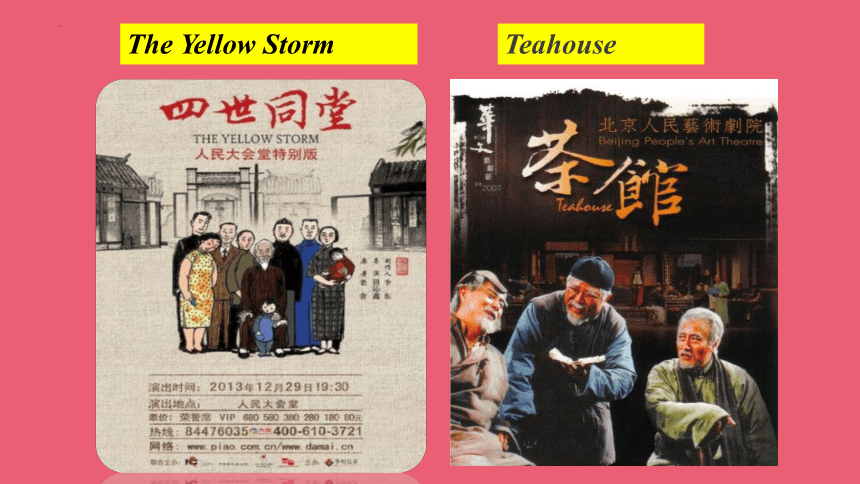
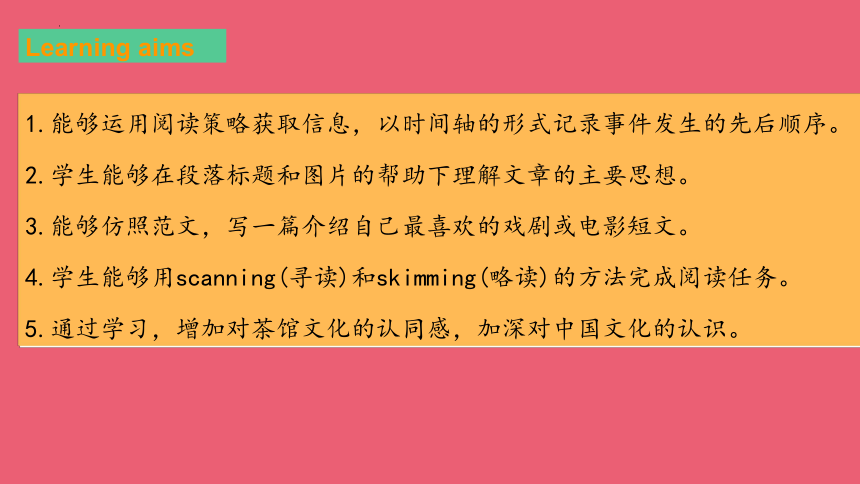
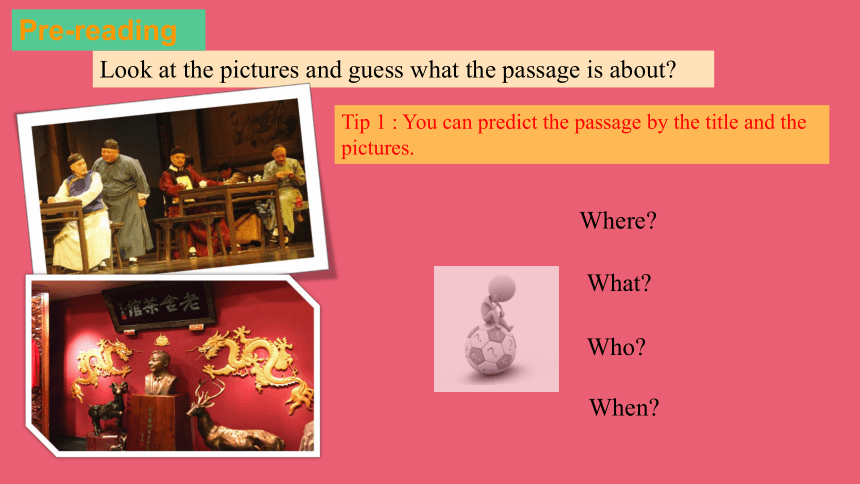
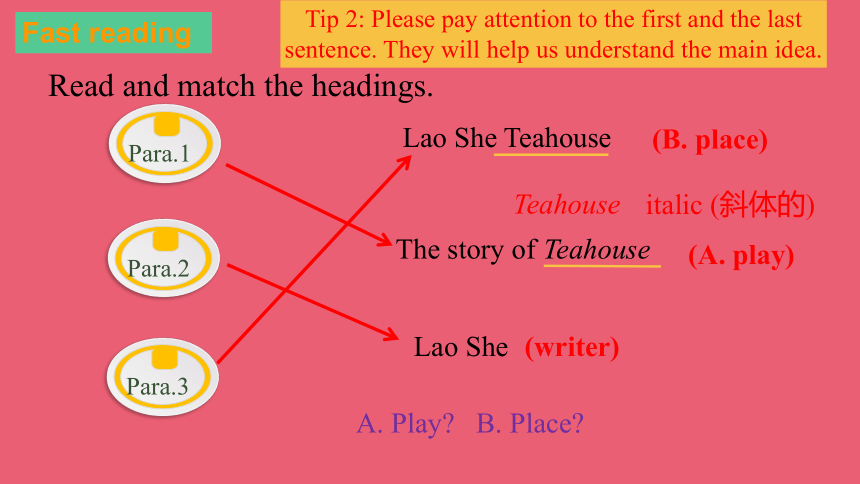
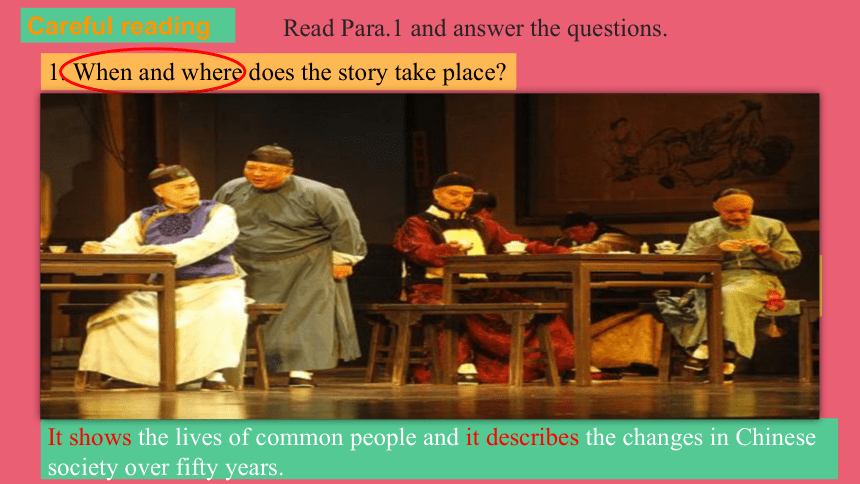
文档简介
(共24张PPT)
Module 5 Unit 2
It describes the changes in Chinese Society.
Where is it
It is Lao She Teahouse.
Who can introduce (介绍)Lao She
Lao She is one of the greatest Chinese writers of twentieth century. He was named “the People’s Artist”.(人民艺术家)
Pen name
Lao She
Real name
Shu Qingchun
What are his most famous novels and plays
The Dragon Beard Ditch
Camel Xiangzi
The Yellow Storm
Teahouse
Learning aims
1.能够运用阅读策略获取信息,以时间轴的形式记录事件发生的先后顺序。
2.学生能够在段落标题和图片的帮助下理解文章的主要思想。
3.能够仿照范文,写一篇介绍自己最喜欢的戏剧或电影短文。
4.学生能够用scanning(寻读)和skimming(略读)的方法完成阅读任务。
5.通过学习,增加对茶馆文化的认同感,加深对中国文化的认识。
Look at the pictures and guess what the passage is about
Tip 1 : You can predict the passage by the title and the pictures.
Where
What
Who
When
Pre-reading
Para.1
Lao She Teahouse
The story of Teahouse
Lao She
Read and match the headings.
Para.2
Para.3
Tip 2: Please pay attention to the first and the last sentence. They will help us understand the main idea.
(A. play)
(B. place)
(writer)
A. Play B. Place
Teahouse
italic (斜体的)
Fast reading
Read Para.1 and answer the questions.
1. When and where does the story take place
3. Why is it good
2. What is the story about
It takes place from the end of the nineteenth century to the middle of the twentieth century in Beijing.
It tells us the story of Wang Lifa and the customers of his teahouse in Beijing.
It shows the lives of common people and it describes the changes in Chinese society over fifty years.
Careful reading
born in Beijing
finished school and became a head teacher of a primary school
left home and went to England
wrote Teahouse
1957
1924
1913
1899
Read Para.2 and complete the timeline.
1918
went to a teacher’s school
Time order
Experiences
Careful reading
Lao She
Retell the paragraph according to the timeline
1957
1924
1918
1913
1899
______________________________________________________________________________________________________________________________________________________________________________________________________
was born in Beijing
wrote Teahouse
left home and went to England
finished school and became the head teacher of a primary school
went to a teacher’s school
Careful reading
Past tense
2016
1. What can we do at Lao She Teahouse
magic show
What to taste
What to enjoy
Lao She Teahouse
Beijing food
tea
Beijing opera
traditional music
Read Para.3 and answer the questions.
Chinese Kungfu
Tea show
cross talk
acrobatics
Lao She Teahouse gives a warm welcome to everyone.
Careful reading
Lao She is one of the greatest Chinese writers of the twentieth century.
He was named “the People’s Artist”.
Camel Xiangzi
Four Generations under one roof(屋檐)
Longxu Ditch
novel [ n vl] 小说
Teahouse
Lao She’s achievement(成就)
Post reading
Qi Baishi
“the People’s Artist”
Chang Xiangyu
“the People’s Artist”
(1923-2004)
famous Yu Opera artist
Yu Opera 豫剧
coffee house
Lao She Teahouse
Will Lao She Teahouse still be popular in the future
Post reading
Read and think
Which do you like better, teahouses or coffee houses
Let’s discuss and make a report.
Hello, everyone. It’s my great honor to show our ideas. We hold the view that....
First,...
Second,...
Third,...
teahouses
coffee houses
Post reading
Let’s believe.
tells who we are.
tells us where we are.
tells us why we are different from the others.
What belongs to the nation belongs to the world.
(只有民族的,才是世界的。)
Traditional
culture
Post reading
Teahouse
Lao She
Today’s Lao She Teahouse
Who When
Where What Why
Experiences...
Achievement...
What to taste
What to do
Summary
Language points
“one of +the +最高级+名词复数 ”表示“最....中的一个”,注意最高级前加the, 后面的名词要用复数形式。注意: 如果最高级前有名词所有格或者物主代词修饰,就不需要加the。
shanghai is one of the biggest cities in China.
①tell做及物动词,意为“告诉,讲述”,后可接双宾语:tell sb. sth. =tell sth. to sb. 意为“告诉某人做某事”。如:
Can you tell me your old school 你能告诉我你原来的学校吗?
②tell sb. to do sth.意为“告诉某人做某事”,其否定结构为tell sb. not to do sth.意为“告诉某人不要做某事”。如:
Mum told me to get some hot water. 妈妈叫我去弄些热水来。
He told us not to buy things in this shop. 他告诉我们不要在这个商店买东西。
Language points
return to sp.返回某地, 相当于go back to sp.
return 还表示“归还”,常用语return sb sth.=return sth to sb.把某人还给某人
Eg. (1) Tom went back to England with his parents.(同义句)
Tom returned to England with his parents.
(2)翻译:你把书还给他了吗?
Did you return this book to him
name是动词,意为“命名”;“was named”是被动语态,be named意为“被命名为/被叫做……”,也可写成be called。其主动语态是name/call sb. sth.,意为“叫某人……”
We name/call that boy Xiaoming. 我们叫那个男孩小明。
This boy is named Jack. 这个男孩叫杰克。
This small village is named Hongqi。这个小村庄被叫做红旗。
Language points
give (sb.) a … welcome 意为“对(某人)表示…… 欢迎”,也可以用give a ....welcome to sb.,因为give 为双宾语结构give sb sth=give sth to sb.。
Eg. 翻译:(1)青岛热情地欢迎来自世界各地的人们。
Qingdao gives a warm welcome to people all over the world
Exercise
1.My mother always told (story) to me when I was young.
2.Tomorrow is Li Hao’s (nineteen) birthday.
3.Lao She was (name) “the People’s Artist” because of his great works.
4.The West Lake in Hangzhou is one of the (famous) lakes in China.
5.The (life) of most people were poor in the past.
6.My sister graduated from a (teacher) school in 2020.
7.After (leave) the school, he went to the supermarket.
8.My little sister likes reading and she’d like to be a (write).
stories
nineteenth
named
most famous
lives
teacher’s
leaving
writer
Level 1:
Recite the first paragraph and try to introduce the play Teahouse.
Level 2:
1. Learn more about our Chinese traditional culture;
2. Think about how to spread the Chinese traditional culture.
Homework
Module 5 Unit 2
It describes the changes in Chinese Society.
Where is it
It is Lao She Teahouse.
Who can introduce (介绍)Lao She
Lao She is one of the greatest Chinese writers of twentieth century. He was named “the People’s Artist”.(人民艺术家)
Pen name
Lao She
Real name
Shu Qingchun
What are his most famous novels and plays
The Dragon Beard Ditch
Camel Xiangzi
The Yellow Storm
Teahouse
Learning aims
1.能够运用阅读策略获取信息,以时间轴的形式记录事件发生的先后顺序。
2.学生能够在段落标题和图片的帮助下理解文章的主要思想。
3.能够仿照范文,写一篇介绍自己最喜欢的戏剧或电影短文。
4.学生能够用scanning(寻读)和skimming(略读)的方法完成阅读任务。
5.通过学习,增加对茶馆文化的认同感,加深对中国文化的认识。
Look at the pictures and guess what the passage is about
Tip 1 : You can predict the passage by the title and the pictures.
Where
What
Who
When
Pre-reading
Para.1
Lao She Teahouse
The story of Teahouse
Lao She
Read and match the headings.
Para.2
Para.3
Tip 2: Please pay attention to the first and the last sentence. They will help us understand the main idea.
(A. play)
(B. place)
(writer)
A. Play B. Place
Teahouse
italic (斜体的)
Fast reading
Read Para.1 and answer the questions.
1. When and where does the story take place
3. Why is it good
2. What is the story about
It takes place from the end of the nineteenth century to the middle of the twentieth century in Beijing.
It tells us the story of Wang Lifa and the customers of his teahouse in Beijing.
It shows the lives of common people and it describes the changes in Chinese society over fifty years.
Careful reading
born in Beijing
finished school and became a head teacher of a primary school
left home and went to England
wrote Teahouse
1957
1924
1913
1899
Read Para.2 and complete the timeline.
1918
went to a teacher’s school
Time order
Experiences
Careful reading
Lao She
Retell the paragraph according to the timeline
1957
1924
1918
1913
1899
______________________________________________________________________________________________________________________________________________________________________________________________________
was born in Beijing
wrote Teahouse
left home and went to England
finished school and became the head teacher of a primary school
went to a teacher’s school
Careful reading
Past tense
2016
1. What can we do at Lao She Teahouse
magic show
What to taste
What to enjoy
Lao She Teahouse
Beijing food
tea
Beijing opera
traditional music
Read Para.3 and answer the questions.
Chinese Kungfu
Tea show
cross talk
acrobatics
Lao She Teahouse gives a warm welcome to everyone.
Careful reading
Lao She is one of the greatest Chinese writers of the twentieth century.
He was named “the People’s Artist”.
Camel Xiangzi
Four Generations under one roof(屋檐)
Longxu Ditch
novel [ n vl] 小说
Teahouse
Lao She’s achievement(成就)
Post reading
Qi Baishi
“the People’s Artist”
Chang Xiangyu
“the People’s Artist”
(1923-2004)
famous Yu Opera artist
Yu Opera 豫剧
coffee house
Lao She Teahouse
Will Lao She Teahouse still be popular in the future
Post reading
Read and think
Which do you like better, teahouses or coffee houses
Let’s discuss and make a report.
Hello, everyone. It’s my great honor to show our ideas. We hold the view that....
First,...
Second,...
Third,...
teahouses
coffee houses
Post reading
Let’s believe.
tells who we are.
tells us where we are.
tells us why we are different from the others.
What belongs to the nation belongs to the world.
(只有民族的,才是世界的。)
Traditional
culture
Post reading
Teahouse
Lao She
Today’s Lao She Teahouse
Who When
Where What Why
Experiences...
Achievement...
What to taste
What to do
Summary
Language points
“one of +the +最高级+名词复数 ”表示“最....中的一个”,注意最高级前加the, 后面的名词要用复数形式。注意: 如果最高级前有名词所有格或者物主代词修饰,就不需要加the。
shanghai is one of the biggest cities in China.
①tell做及物动词,意为“告诉,讲述”,后可接双宾语:tell sb. sth. =tell sth. to sb. 意为“告诉某人做某事”。如:
Can you tell me your old school 你能告诉我你原来的学校吗?
②tell sb. to do sth.意为“告诉某人做某事”,其否定结构为tell sb. not to do sth.意为“告诉某人不要做某事”。如:
Mum told me to get some hot water. 妈妈叫我去弄些热水来。
He told us not to buy things in this shop. 他告诉我们不要在这个商店买东西。
Language points
return to sp.返回某地, 相当于go back to sp.
return 还表示“归还”,常用语return sb sth.=return sth to sb.把某人还给某人
Eg. (1) Tom went back to England with his parents.(同义句)
Tom returned to England with his parents.
(2)翻译:你把书还给他了吗?
Did you return this book to him
name是动词,意为“命名”;“was named”是被动语态,be named意为“被命名为/被叫做……”,也可写成be called。其主动语态是name/call sb. sth.,意为“叫某人……”
We name/call that boy Xiaoming. 我们叫那个男孩小明。
This boy is named Jack. 这个男孩叫杰克。
This small village is named Hongqi。这个小村庄被叫做红旗。
Language points
give (sb.) a … welcome 意为“对(某人)表示…… 欢迎”,也可以用give a ....welcome to sb.,因为give 为双宾语结构give sb sth=give sth to sb.。
Eg. 翻译:(1)青岛热情地欢迎来自世界各地的人们。
Qingdao gives a warm welcome to people all over the world
Exercise
1.My mother always told (story) to me when I was young.
2.Tomorrow is Li Hao’s (nineteen) birthday.
3.Lao She was (name) “the People’s Artist” because of his great works.
4.The West Lake in Hangzhou is one of the (famous) lakes in China.
5.The (life) of most people were poor in the past.
6.My sister graduated from a (teacher) school in 2020.
7.After (leave) the school, he went to the supermarket.
8.My little sister likes reading and she’d like to be a (write).
stories
nineteenth
named
most famous
lives
teacher’s
leaving
writer
Level 1:
Recite the first paragraph and try to introduce the play Teahouse.
Level 2:
1. Learn more about our Chinese traditional culture;
2. Think about how to spread the Chinese traditional culture.
Homework
同课章节目录
- Module 1 How to learn English
- Unit 1 Let's try to speak English as much as possi
- Unit 2 You should smile at her.
- Unit 3 Language in use .
- Module 2 My home town and my country
- Unit 1 It's taller than many other buildings.
- Unit 2 Cambridge is a beautiful city in the east o
- Unit 3 Language in use .
- Module 3 Sports.
- Unit 1 Nothing is more exciting than playing tenni
- Unit 2 This year we training more carefully.
- Unit 3 Language in use .
- Module 4 Planes, ships and trains .
- Unit 1 He lives the farthest from school.
- Unit 2 What is the best way to travel.
- Unit 3 Language in use .
- Module 5 Lao She Teahouse.
- Unit 1 I wanted to see the Beijing Opera.
- Unit 2 It descibes the changes in Chinese society.
- Unit 3 Language in use .
- Module 6 Animals in danger.
- Unit 1 It allows people to get closer to them .
- Unit 2 The WWF is working hard to save them all.
- Unit 3 Language in use .
- Revision module A
- Module 7 A famous story
- Unit 1 Alice was sitting with her sister by the ri
- Unit 2 She was thinking about her cat.
- Unit 3 Language in use .
- Module 8 Accidents
- Unit 1 While the car were changing to red, a car s
- Unit 2 I was trying to pick it up when it bite me
- Unit 3 Language in use .
- Module 9 Population
- Unit 1 The population of China is about 1.37 billi
- Unit 2 Arnwick was a city with 200,000 people.
- Unit 3 Language in use .
- Module 10 The weathe
- Unit 1 It might snow.
- Unit 2 The weather is fine all year round.
- Unit 3 Language in use .
- Module 11 Way of life
- Unit 1 In China ,we open a gift later.
- Unit 2 In England, you usually drink tea with milk
- Unit 3 Language in use .
- Module 12 Help
- Unit 1 What should we do before help arrives?
- Unit 2 Stay away from windows and heavy furniture.
- Unit 3 Language in use .
- Revision module B
